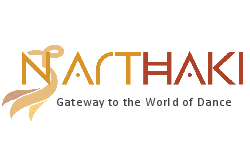
|   |

|   |
Evam festival honored legacy of Bharatanatyam heritage in Mumbai - Chandra Anand e-mail: chandra6267@yahoo.co.in Photos: Suresh Muraleedharan April 12, 2025 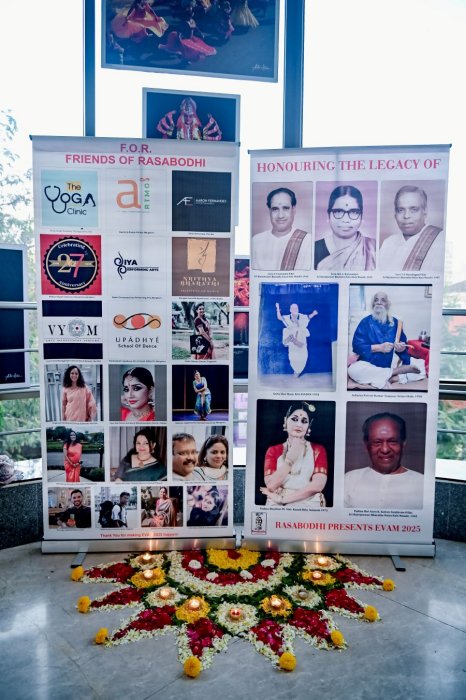 Rasabodhi Arts Foundation presented Evam, a two-day festival in Mumbai. The first day was about recognizing the legacy of Bharatanatyam heritage in Mumbai by celebrating the contributions of grand legendary gurus Govindaraj Pillai, Mahalingam Pillai, Kalyanasundaram Pillai, Acharya Parvatikumar, Dr. Kanak Rele and 'Kalasadan' Mani and to honour them as the torch bearers of the art form for it was they who initially spread the art of Bharatanatyam in the city. Accordingly, the performances were presented by the institutions they started in Mumbai. 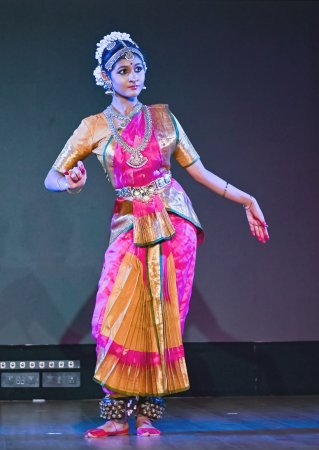 Sri Rajarajeswari Bharatha Natya Kala Mandir Sri Rajarajeswari Bharatha Natya Kala Mandir, the very first institution established in Mumbai in 1945, completing 80 years, was considered as the father figure for all other institutions of Bharatanatyam. A performance conducted by Harikrishna Kalyanasundaram, the young director of the school, who represents the seventh generation of the parampara of teaching this style of dance since 300 years, presented his student Janaki Unnikrishnan in a short performance of half hour. Presentation of Rama kavuthvam and tillana composed and choreographed by him, wherein the skills of the new generation carrying the heritage of the family profession forward had crystallized, was showcased. In Rama kavuthvam, the grace, compassion and valour of Rama was extolled through padartha bhava, and was pointed out that when we remember him daily we can find salvation in the cycle of life and death. The lyrics were interspersed with pure nritta in good medley of three speeds in every avartana, and the item was performed with clarity and restraint. The javali (Behag, roopakam) "Saramaina matalantha chalu chalu ra", a composition of Maharaja Swati Thirunal, choreographed by Harikrishna Kalyanasundaram displayed the kandita nayika. Tillana (Telang, adi) with lyrics in praise of Lord Krishna displayed prominently a nritta piece called gettu, which was a dynamic conversation between the nattuvanar's sollus, the salangai's resonant echoes from the dancer's intricate footwork, and the deft rhythms of the mridangam. The dancer had a light and graceful appearance and could have worked on her araimandi stance. Guru Kalyanasundaram was also present with his wife Mythili observing the performance. Guru Mani's institute Kalasadan established in 1954, presented his compositions and choreographies in his memory. He was a student of Guru A.T. Govindaraj Pillai and his wife Guru Karunambal who were the founder directors of Sri Rajarajeswari Bharatha Natya Kala Mandir under the guidance of Guru Kuppiah Pillai. Kalasadan Mani as he was famously called, also taught Carnatic music along with Bharatanatyam in his school. After his death, the school is now in the capable hands of his son, daughters, sons-in-law and grandchildren. Kalasadan is now engaged in setting up a unique arts complex called Chintamani Ashram of Fine Arts, at Titwala, which had been a dream project of Guru Mani. 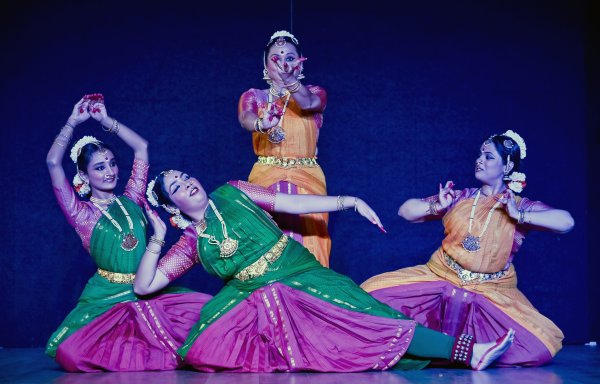 Kalasadan The performance was conducted by his son Natrajgopal Mani, and his daughter Sharada Ganeshan, who is also a student of Dr. Kanak Rele. They presented four students of whom, one was Guruji's granddaughter, Nandini Ganesan. Commencing the performance with a brisk pushpanjali, she followed it with a shloka "Vakratunda mahakaya" and proceeded to the varnam, "Karunalaya nidhiye, kanaksabhesane" (Anandabhairavi, adi) where the lyrics composition and choreography were by Mani Sir. Here it was showcased how Guru Mani choreographed the same item differently for a solo performer and for a group performance. The jathis were crisp and the sancharis were done in an elegant manner. The 51st verse of Soundarya Lahiri of Adi Shankara Bhagavad Pada describing the 8 emotions emanating from the eyes of Devi was performed by Nandini Ganesan, This choreography of Kalasadan Mani was taught to her by her mother Sharada who had learnt it from her father. And as Nandini had training from Guru Chitra Visweswaran for some time, some bearings she had imbibed from her was also reflected in the performance. They concluded with a brisk tillana in ragam Shuddha Dhanyasi. There seemed to be a marked difference in the presentations of both the schools, confirming that Mani Sir had managed to bring his own mark on the performance design of Bharatanatyam. 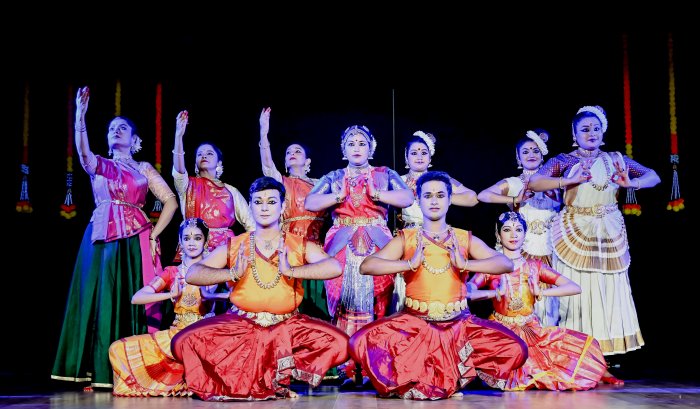 Nalanda Dr. Kanak Rele was a Mohiniattam exponent, choreographer and an academician. She is credited with having played a key role in the revival and popularisation of Mohiniattam and for having brought a scientific temper and academic rigour to it. Rele is noted for the contemporizing of mythological tales in her performances and her portrayal of strong women characters in them - Kubja, Kalyani, Gandhari - and highlighting the trauma of women in society. She was the founder-director of the Nalanda Dance Research Centre and the founder-principal of the Nalanda Nritya Kala Mahavidyalaya in Mumbai. It is affiliated to the University of Mumbai and trains students in Bharatanatyam, Mohiniattam and Kathak for university degree courses. And Uma Rele, the present principal of the institute, conducted the performance presentation in her memory. She herself is a post graduate and Ph.D in dance and is currently the most sought after Ph.D. guide for University of Mumbai, a senior NAAC Assessor for other institutions. They presented 'Panchamahabhutas - the elements', based on the hymns of the Vedas. This item was performed in a jugalbandi of three styles of Bharatanatyam, Mohiniattam and Kathak. Beautifully choreographed by Dr. Kanak Rele in 2014, this presentation showed how the earth was formed, the elements of nature joined to create man and how nature the best teacher taught him to live in harmony with blessings of Mother Earth. All forms were represented well in the theme and aptly used to display the elements. The participants performed very well. Acharya Parvatikumar learned Bharatanatyam under Guru Chandrashekhar Pillai. He also learned several compositions from Guru Mahalingam of Sri Rajarajeswari Bharatha Natya Kala Mandir and Mylapore Gauri Amma. He learned Kathakali from Guru Karunakar Panikar and Kathak from Guru Ratikant Arya and Guru Sunder Prasad. He has contributed immensely to the field of dance through his path-breaking scholarly approach to Indian classical dance study, performance and choreography. His work includes the research and choreography of the Sanskrit text of dance Abhinaya Darpanam and Raja Sarfoji's Marathi Nirupanas. Abhinaya Darpanam is his key contribution to Bharatanatyam in which he choreographed the entire text into an audio-visual format which is saved at IGNCA, Delhi for archival purposes. His Magnum Opus (1982) of 'Tanjavur Nritya Prabandha' was a path breaking research on the 'Nirupanas of Tanjavur Kings.' This book gives, in Devanagiri script, the dance compositions of Raja Sarfoji with notations of jatis and adavus to be performed for each line of the Sahitya. 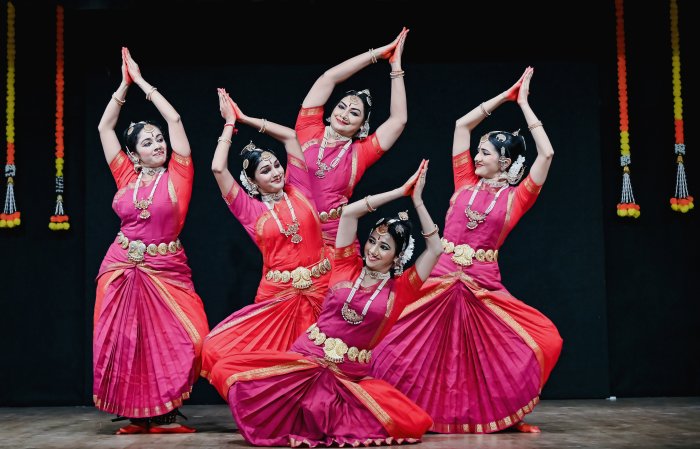 Bharata College His heritage is taken forward by Guru Sandhya Purecha who has founded Bharata College of Fine Arts and Culture, Mumbai, a pioneering college blending tradition and innovation in its approach to dance as a performing and pedagogical art. Affiliated with Kavikulaguru Kalidas Sanskrit University, Ramtek, and recognized by UGC, it offers Pre-degree, Bachelor's and Master's programs in Bharatanatyam, Kathak, Kuchipudi, Odissi, and Manipuri. With a curriculum combining theory (Shastra) and practice (Sampradaya), students gain expertise in dance, music, rhythm, choreography, yoga, and research into Indian aesthetics and cultural history, preparing them to be artistes, researchers, and creators. The college was awarded the Academic Excellence Award in 2019. Purecha is well remembered for performing Abhinaya Darpanam for her guru's audio-visual format and many stage presentations of the same. Today, she is at the helm of the Sangeet Natak Akademi propagating the cultural scene of India to reach greater heights. She presented her students where she showcased her Guruji's choreography and two items choreographed by herself - Jaya Jaya sharanu and Allaru (Pantuvarali, tisra ata), famously known as todayamangalam and alarippu. The interesting thing was they danced to music recorded in 1978 featuring the voices of Dadaguruji as Parvatikumar was popularly known as and Amma, his wife. Todayamangalam extolled the greatness of the goddess in her various forms killing demons like Shumba, Nishumba, Kaitaba etc. Devi stuthi extolled the greatness of Goddess Durga in her various forms of Mahalakshmi, Saraswathi and Mahakali to verses from Sri Durga Saptashati. Shloka "Sarvamangala mangalye" was performed with grace and devotion by Chitra Dalvi and then the group danced to the verses using karanas for their nritta piece, padartha bhava for nritya, displaying dignified poses and gestures when the goddess names were mentioned in the verse. In Shivohum meaning oneness with the absolute, the concept was the soul in its pure form merges with the divine and Bhoomi mangalam shloka reflected the interconnected of all existence. The music was from Isha Foundation. 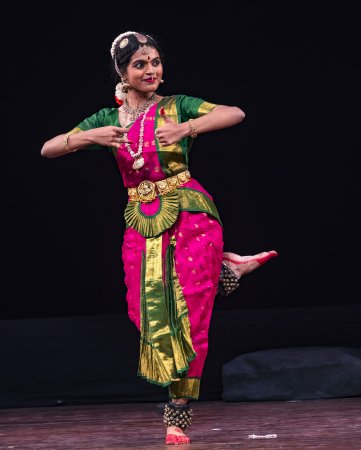 Swathi Krishnakumar On day 2, Swathi Krishnakumar, disciple of Poornima Gururaja, performed ashtadikpalaka pushpanjali, a composition choreographed in 1960 where the recording was done in 1963. This item had been passed on to her in the original form making it a glimpse into the history of the Mysore sampradaya. It opened with a shloka as a prayer and the pushpanjali followed, ending with Ganesha Kavuthvam. Her movements were easy, neat, clean and abhinaya natural. Javali (Kambodhi, chatushra ekam) was done with appropriate abhinaya to the lyrics. 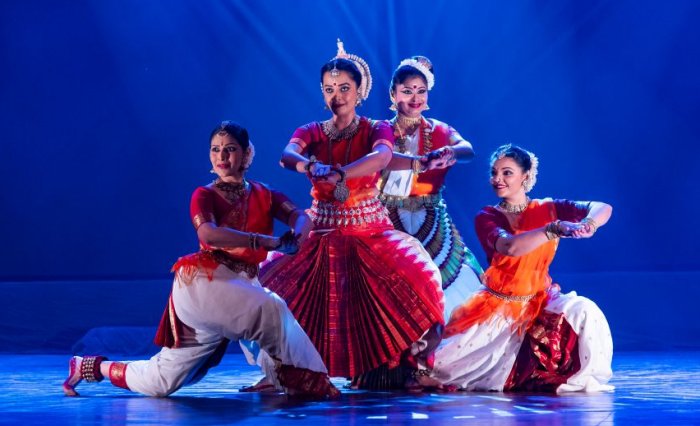 Dashavatar Dashavatar was a very interesting premiere presentation where four classical styles came together. It was performed by Prachi Saathi- Bharatanatyam, Namrata Mehta - Odissi, Saji Menon - Mohiniattam and Bhakti Deshpande - Kathak. The song "Pralaya payodijale" from Jayadeva's Geeta Govindam was chosen to present this performance. It was a well-coordinated presentation where the portions each did was aptly suited to their style. The episodes were well brought out. The colours of the costume were in red, orange and white. The half hour choreography had the audience enraptured. The beautiful music and excellent lighting supported their presentation marvelously.  Rahasya The concluding performance for the Evam festival in Mumbai was thematic premiere presentation called 'Rahasya', a collaboration of Rama Vaidyanathan and Vaibhav Arekar. They had a live ensemble for support and started with an innovative alarippu in tisra ekam where they came in holding the kapota hasta signifying secret. And as the music unravelled in its customary three speeds dynamics, the expression on how all secrets need to be kept, cajoled to be let out, and denies access to it was beheld. It was interesting as one could recognize their own experiences of keeping secrets. While Rama looks for Shiva in the tiniest atom, Vaibhav looks for him in the 'akaasa' and in the 'akasha within the human being'. With ardha suchi hasta, Rama indicates the atom, the param porul. Using verses from Thirumular's Thirumandiram, she explains certain truths about it, in-between the lyrics were interspersed with nritta pieces danced to tanam and cholkattu. It is a substance that cannot be explained or understood by intellect. It is that substance without the cycle of life and death, from which this existence has developed and one can see it in the attributes of Shiva, and the elements that make the earth; an abstract thing that has to be experienced like the fragrance of the flower. Vaibhav presented the secret of akasa within by interpreting the song "Ananda Natana prakasham," a keertanam by Muthuswami Dikshitar. He showed padartha bhava to lyrics, briefly depicted the Markandeya story, elaborated on the words sangeeta, vaadya and tandava. He interspersed the lyrics with nritta to cholkattu and swara phrases, reached the temple and did aarti and salutations and finished with Nataraja poses. Rama presented Janabai who wanted to reveal her secret to all. Her secret was she wanted to have a relationship with Vittala. She wanted to be a courtesan and Vithoba her customer. Janabai, a lady of the 13th century, a maid in the house of Namadeva, who learnt about Bhakti yoga from the religious discourses she heard in the house, was shown with the bearings of a very sophisticated prostitute. This song she wrote was perhaps to mean that her physical form too was dedicated to her lord, whose glory she sings and put up a shanty at Pandarpur to be close to him whom she says should make a house in her body, which would help her reach his abode. The first line indicated that she is confident that she is now ready to break away from the shackles of physical life and its constraints. She actually had a sakhyam relationship with him and always saw Vittala as an extension of Rukhmabai. 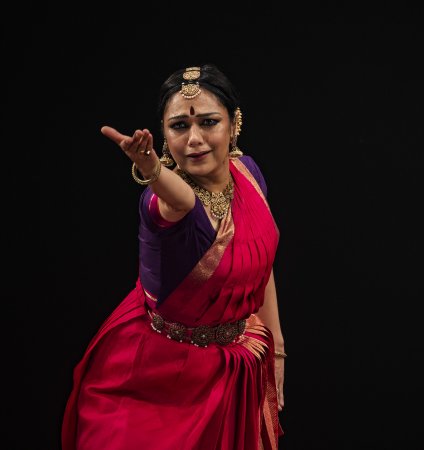 Rama Vaidyanathan 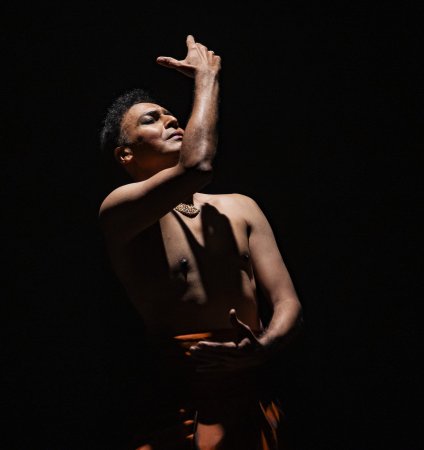 Vaibhav Arekar Vaibhav quoted Basavanna saying that it is the body that allows to hold secrets and have relationships. Body is the temple where the legs are the pillars, body is the shrine and head is the kalasa. Kabir takes it further and says, treat the body like a tanpura, tune it and when it is tuned, it is his sound which is pure in nature that is heard. The body is an object to be used to understand his cosmic energies in your body. This is the secret one has to understand. Presenting a few verses of Basavanna's poem expressing the above idea in padartha bhava, Vaibhav went on to depict the interpretation of Kabir's doha. He used sound of his gunghroos for the tuning of his body - the tanpura made of five elements in nature. A lot of jathi pieces were presented. And Hebbar's evocative singing helped the concept reach its climax. A good opportunity to showcase teermanam korvais was lost. This would have added weightage to the presentation. The last presentation was inspired from Loka Mahabharata. Here they presented the characters of Karna and Draupadi. The similarities in their life, the way they were witness to the injustices experienced by both at the courts and how they sympathized with each other was shown. Thus, what secret lay in the relationship between them is a secret to be wondered. It was a short theatrical presentation where dance, music and vachika abhinaya played a good role in enhancing the value of the piece, with great support from live music ensemble and light design. The 3rd day of Evam festival was conducted in Pune in collaboration with Kalayaan, an institution based in Pune founded by Rama Kukunur. It began with a performance by Kalyani Hema Nair from Singapore who was placed 2nd in the Natyam Sparda competition. Guru Sucheta Chapekar's solo was part of 'Honouring Legacy' for her unparalleled contribution to Bharatanatyam in Maharashtra followed by 'Rahasya,' a duet performance by Rama Vaidyanathan and Vaibhav Arekar. 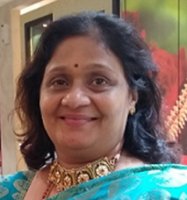 Chandra Anand is a Bharatanatyam artiste and teacher. She has an MA in Bharatanatyam from Tilak Maharashtra Vidyapeeth, and her series on 'Education in spiritual values through Bharatanatyam' is featured in narthaki.com. |